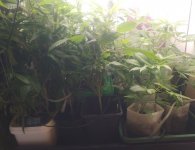little-soldier
Active member
best way to save money would be study and gather some data on how much of direct and indirect sunlight the plant really needs in a day outdoors and apply it to indoor lighting instead of going the lazy 12/1 route. Would be cool to walk in a grow room and have the lights slowly dimming every now and then. lights would probably last longer that way too so it would be a positive double whammy!
maybe i should patent my idea
maybe i should patent my idea




